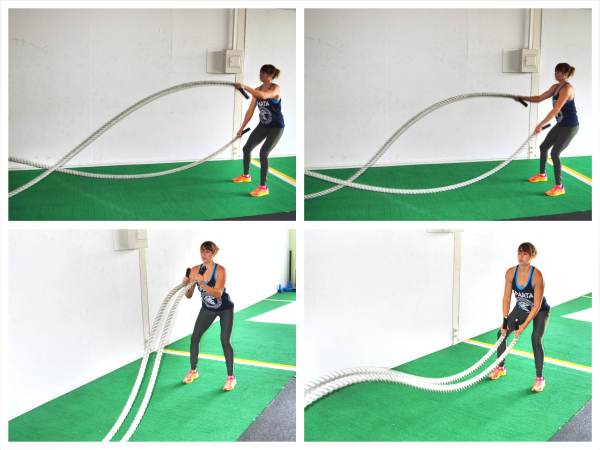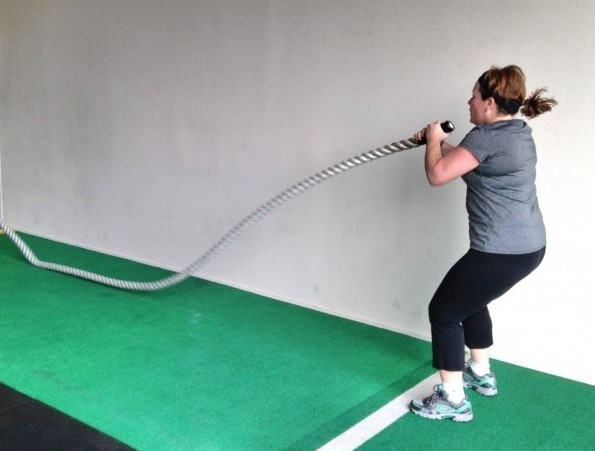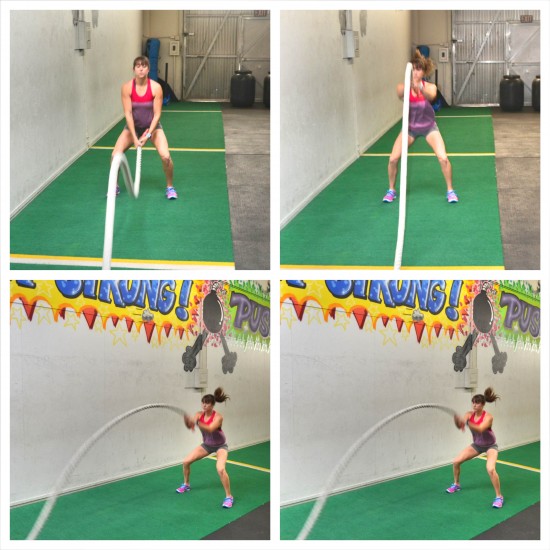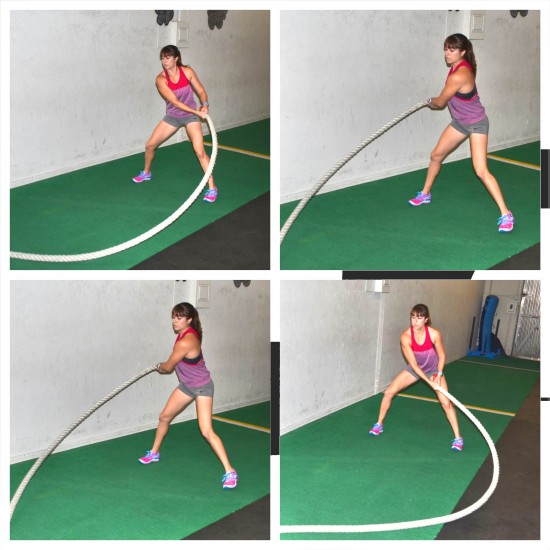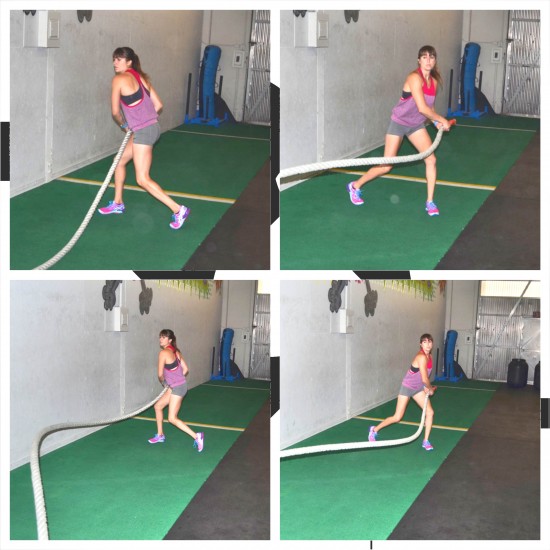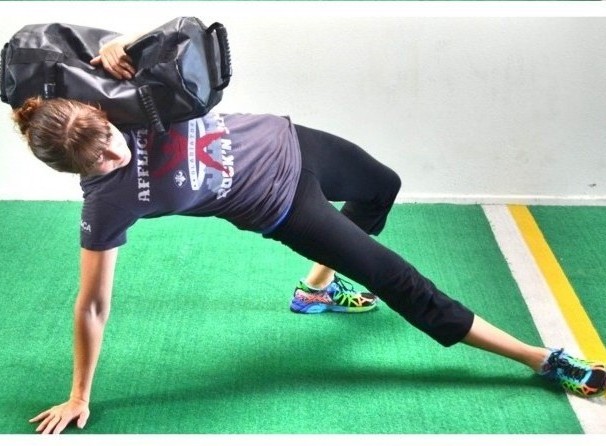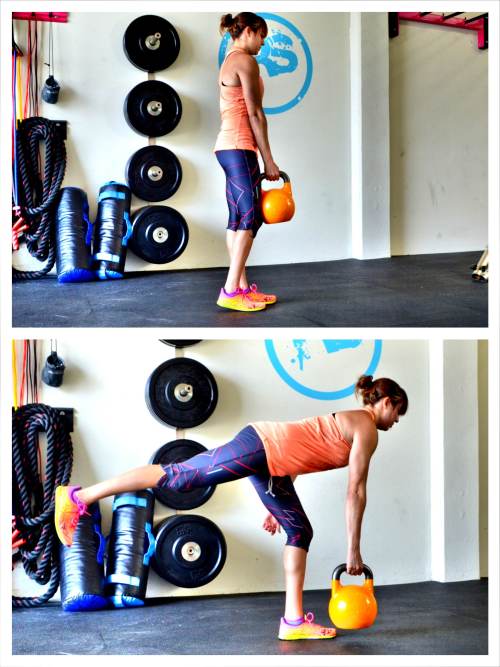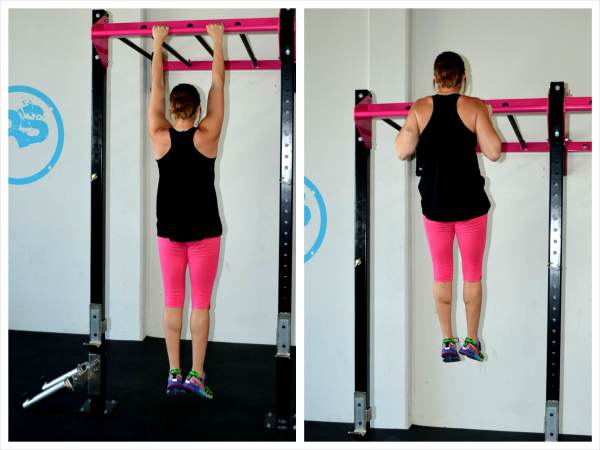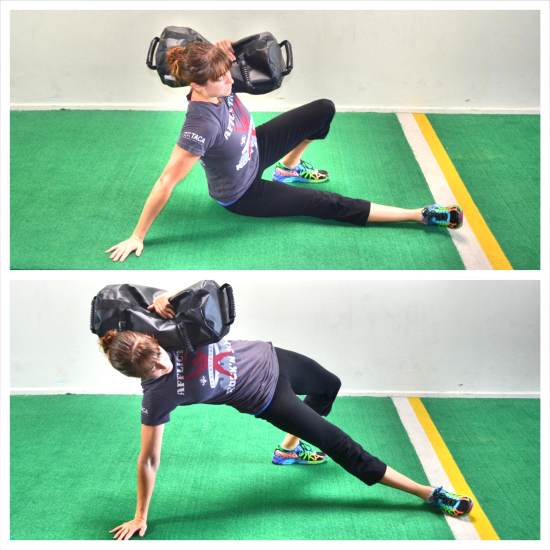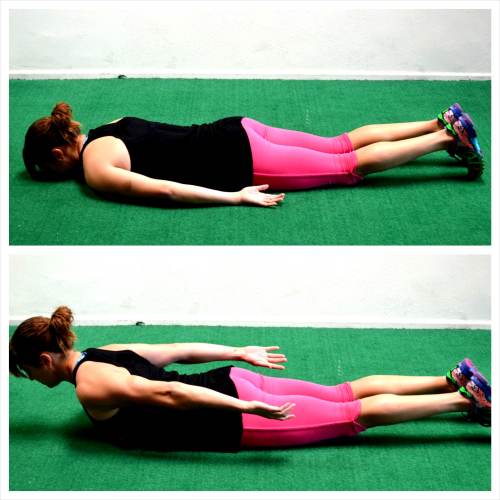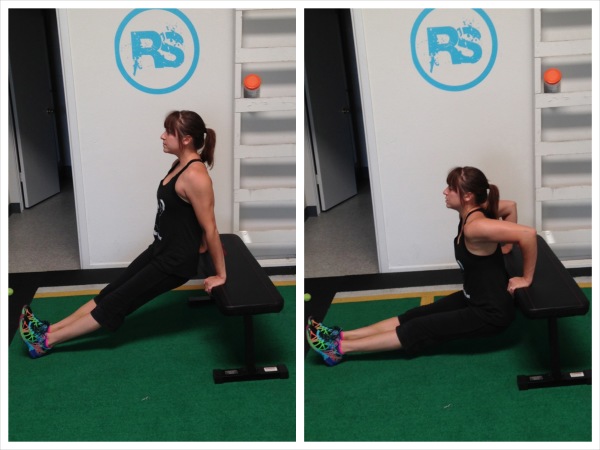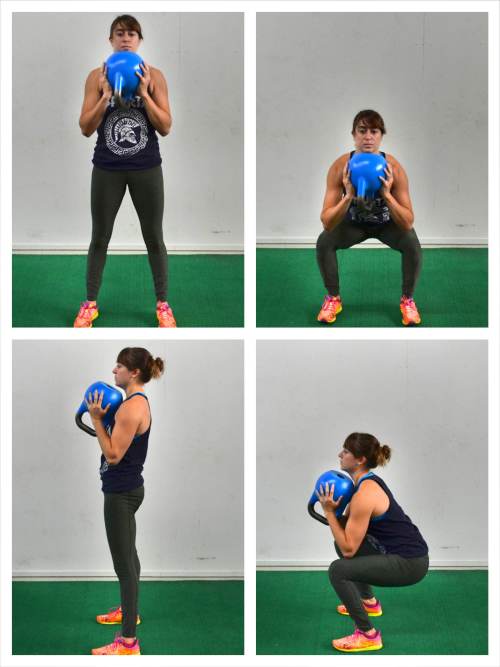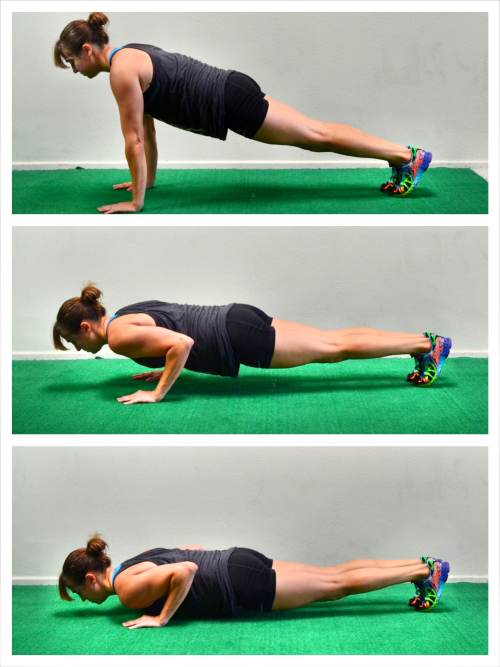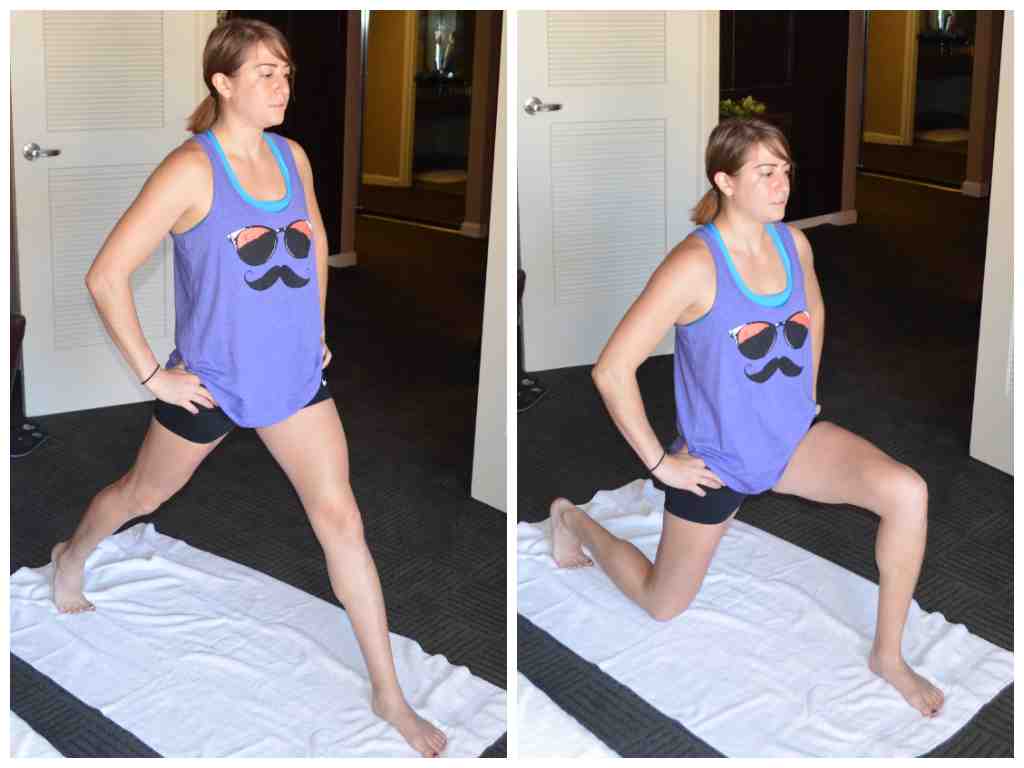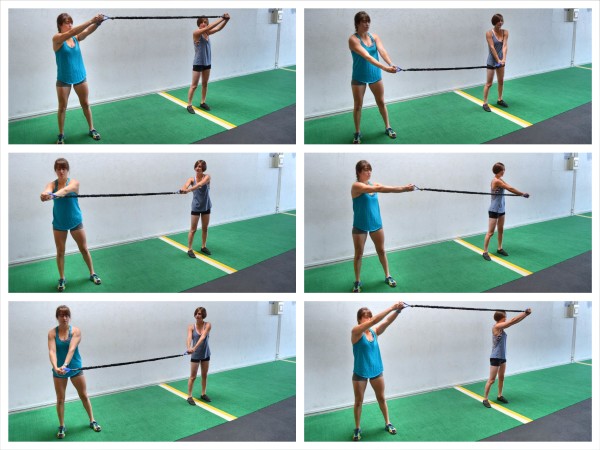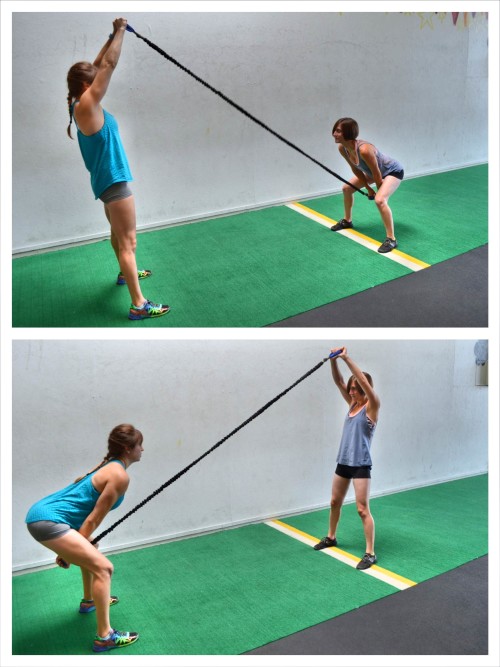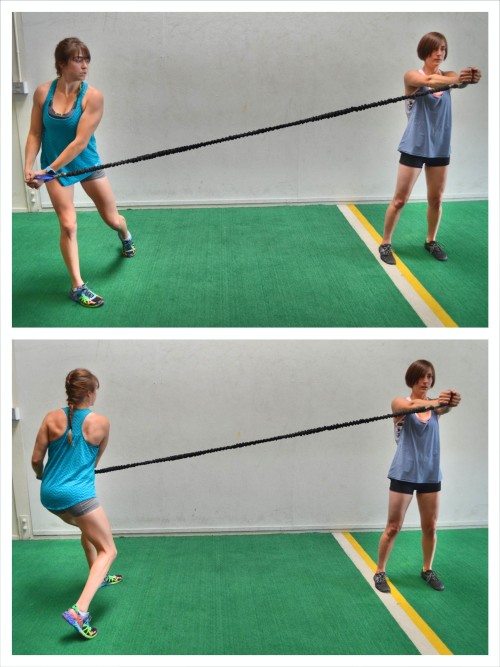
by Cori Lefkowith | Dec 15, 2013
WARM UP
Stretch and Roll Out:
Hips/Glutes
Back
Lats
Chest
Shoulders
WORKOUT
One partner will hold a plank on the end of the rope for 30 seconds while the other partner does their rope drill for 30 seconds. Then they will switch. After both have gone, they will rest 30 seconds and then repeat.
Pick 5-8 of the rope drills below to include. Do 3-5 rounds of each drill. The more drills you pick, the fewer rounds of each you should do.
CIRCUIT:
30 seconds Rope Drill
30 seconds Plank Hold
30 seconds Rest
ROPE DRILL OPTIONS:
Alternating Arm Waves
Stage Coach
Rainbows
Sidewinders
Side-to-Side Stage Coach
Stage Coach with Backward Lunges
Alternating Waves with Side-to-Side Lunge
Stage Coach with Forward/Backward Hops
Alternating Waves with Side Shuffle
Sidewinders with Forward/Backward Walk
Snakes
Outward Circles
NOTES:
Many of these drills can be done from your feet, knees or even seated. Mix up your positions. For example, you could do a standing Rainbow and then one seated (which is almost like a Russian Twist with the rope).
Mix up the drills that you use!
EXERCISE DESCRIPTIONS:
For Demos of all these moves, check out this Battling Ropes Video.
Stage Coach – Loop the rope around an anchor and hold one side in each hand. Pull the rope out straight then take a step or two in. Hold the rope with the handles facing up. Your arms should be bent slightly and your feet should be about hip-width apart. Bend your knees slightly and then as you stand back up, pull up on the ropes with your arms. Then as you slam the rope back down, squat back down just a little. Move quickly, making small fast waves. Don’t worry about big slams. Keep your chest up and shoulders back as you create the waves. Don’t round forward or keep your legs locked out. Create as many waves as possible. As you advance, step forward closer to the anchor so there is more slack in the rope.
Sidewinders – Loop the rope around an anchor and hold one side in each hand. Keep more slack in the rope than you would with other battling ropes moves. Relax your arms and stand with your feet between hip-width and shoulder-width apart. Then sweep your arms to the right, rotating through your core even pivoting a little up onto your left toes. Then quickly sweep your arms to the left. Sweep back and forth. Keep your arms more relaxed and only slightly bent. Use your core to push and pull from side to side. You shouldn’t do huge rotations. Your arms and the rope should stay out in front of you. The ropes should make snake-like waves on the ground and swish side to side. They should not move up and down off the ground.
Alternating Arms Waves – Loop the rope around an anchor and hold one side in each hand. Pull the rope out straight then take a step or two in. Your arms can be straight or bent depending on which is more comfortable. Your feet should be about hip-width apart. You can be more in a squat or your legs can be straighter. Don’t be afraid to use your legs as you create waves and either move up and down with them together or slightly step one foot at a time. To create the waves, lift one arm up as you pull the rope down with the other. Then switch pulling one up and the other down. Alternate as quickly as possible using the legs as needed.
Rainbows – Loop the rope around an anchor and hold one side in each hand. Pull the rope out straight then take a step or two in. Hold the rope with the handles facing up. Keep your hands pretty close together. Rotate the handles outside your right hip and pivot your left leg. Then pull the rope up and then over toward your left hip. Pivot your right leg as you bring the rope to your left hip. Then arch back up bringing the rope up toward your shoulder than back down to your right hip. Keep pivoting and rotating the rope from hip to hip, arching up toward your shoulders as you bring the rope from one hip to another.
Side-to-side Stage Coach – Loop the rope around an anchor and hold one side in each hand. Pull the rope out straight then take a step or two in. Hold the rope with the handles facing up. Your arms should be bent slightly and your feet should be about hip-width apart. Bend your knees slightly and then as you stand back up, pull up on the ropes with your arms. Then as you slam the rope back down, squat back down just a little. Slam the ropes to one side of your hip. Move quickly, making small fast waves. Don’t worry about big slams. Then bring the rope back and across to the other hip. Keep the stage coach waves moving side to side. Keep your chest up and shoulders back as you create the waves. Don’t round forward or keep your legs locked out. Create as many waves as possible. As you advance, step forward closer to the anchor so there is more slack in the rope.
Stage Coach with Alternating Backwards Lunges – Loop the rope around an anchor and hold one side in each hand. Pull the rope out straight then take a step or two in. Hold the rope with the handles facing up. Your arms should be bent slightly and your feet should be about hip-width apart. Bend your knees slightly and then as you stand back up, pull up on the ropes with your arms. Then as you slam the rope back down, lunge backward. Move quickly, making small fast waves. Your arms will move faster than you lunge. Don’t worry about big slams. Keep your chest up and shoulders back as you create the waves and lunge backward alternating legs. Don’t round forward. As you advance, step forward closer to the anchor so there is more slack in the rope. Also, lunge more quickly.
Alternating Waves with Side-to-Side Lunge – Set your feet nice and wide so that you can go side lunge to side lunge without moving your feet. Hold an end of the rope in each hand. Start with alternating waves and then sink down into a side lunge on one side, bending that knee. Then stay low and move across to a lunge on the other side while keeping the alternating waves going. Do not round your back forward. Keep your chest up nice and tall and your heels down as you create the waves and move side to side.
Stage Coach Forward/Backward Hops – Loop the rope around an anchor and hold one side in each hand. Pull the rope out straight then take a step or two in. Hold the rope with the handles facing up. Your arms should be bent slightly and your feet should be about hip-width apart. Start creating the waves with both arms moving together. As you create the waves, hop forward from foot to foot. Once you go forward a few hops, hop from foot to foot backwards. Keep both arms moving together as you hop. Each hop is one rep.
Alternating Waves with Side Shuffle – Loop the rope around an anchor and hold one side in each hand. Pull the rope out straight then take a step or two in. Your arms can be straight or bent depending on which is more comfortable. Your feet should be about hip-width apart. You can be more in a squat or your legs can be straighter. Don’t be afraid to use your legs as you create waves and either move up and down with them together or slightly step one foot at a time. To create the waves, lift one arm up as you pull the rope down with the other. Then switch pulling one up and the other down. Alternate as quickly as possible using the legs as needed. As you alternate the waves, begin to move laterally with your feet. Shuffle a few feet one way then shuffle back as you keep your arms moving to create the alternating waves.
Sidewinders with Forward/Backward Walk – Loop the rope around an anchor and hold one side in each hand. Keep more slack in the rope than you would with other battling ropes moves. Relax your arms and stand with your feet between hip-width and shoulder-width apart. Then sweep your arms to the right, rotating through your core even pivoting a little up onto your left toes. Then quickly sweep your arms to the left. Sweep back and forth. Keep your arms more relaxed and only slightly bent. Use your core to push and pull from side to side. You shouldn’t do huge rotations. Your arms and the rope should stay out in front of you. The ropes should make snake-like waves on the ground and swish side to side. They should not move up and down off the ground. As you create the waves, step forward. You will first step forward and slightly to the side with your right foot and then your left all the while creating waves. Once you move forward a few feet, step backward. Keeping moving forward and backward while creating waves and keeping your core tight and chest up.
Battling Rope Snakes – Loop the rope around an anchor and hold one side in each hand. Pull the rope out straight then take a step or two in. With your arms relaxed and slightly bent and you feet about hip-width apart, pull the ropes together and then pull them apart. The movement is almost like a chest fly with your arms hanging down. Move quickly creating “snakes” with the ropes on the ground. You can even use your legs to move quickly, squatting just a very little bit and then straightening your legs as you create the waves. Do not round your back. Keep your back flat even if you hinge over just a little.
Battling Ropes Outward Circles – Loop the rope around an anchor and hold one side in each hand. Pull the rope out straight then take a step or two in. With your arms slightly bent, you are going to bend your knees slightly and then start to pull the ropes upward and outward. As you pull them up and out, stand back up. As you pull the rope down and around, squat a little back down and then explode back up as you pull the ropes back up and around. Use your legs to move quickly with the outward circles, pulling down around and then back up and in.

by Cori Lefkowith | Dec 15, 2013
WARM UP
Stretch and Roll Out:
Hips/Glutes
Back
Lats
Chest
Shoulders
WORKOUT
Complete 5 rounds of each circuit. Work for 20 seconds, rest for 40 seconds.
CIRCUIT #1:
20 seconds Basic Tsunami Wave
40 seconds of Rest
CIRCUIT #2:
20 seconds Sidewinder Tsunami Wave
40 seconds of Rest
CIRCUIT #3:
20 seconds Rainbow Tsunami Wave
40 seconds of Rest
COOL DOWN
Stretch and Roll Out:
Hips/Glutes
Back
Lats
Chest
Shoulders
NOTES:
To do any variation of the Tsunami waves in this workout, tie a 50ft (1.5 inch or 2 inch) rope to a pole. You want to just tie one end to an anchor point without losing too much of the length of the rope.
Beginners should definitely use a 1.5 inch rope while more advanced exercisers may want to try a 2 inch rope. However, if you just have an 1.5 inch rope, you can simply step in and keep more slack in the rope to make the moves harder.
Work as hard as you can for the 20 seconds and recovery in the 40 seconds so you an do the exact same amount of work the next round. Beginners may need to do fewer rounds of each circuit and rest longer, making this workout potentially a bit longer than 15 minutes.
EXERCISE DESCRIPTIONS:
Basic Tsunami Wave – Attach the end of a 50ft rope to an anchor point without losing too much of the length of the rope. Holding the rope in both hands, squat down just a little with your arms straight down. As you quickly jump up, pull your arms up toward the ceiling. Then snap your arms back down as you land. Small quick hops with a slight hinge as you raise and lower your arms to create quick small waves. You aren’t trying to jump high off the ground. You are just hopping an inch off the ground and stomping your feet right back down to help you generate more power and not just depend on your arms. Everything should move quickly together.

Sidewinder Tsunami Wave – Attach the end of a 50ft rope to an anchor point without losing too much of the length of the rope. Keep more slack in the rope than you would with other battling ropes moves. Relax your arms, holding the rope in both hands, and stand with your feet between hip-width and shoulder-width apart. Bend your knees slightly and hinge slightly forward. Do not let your back round. Keep your chest up nice and tall. Then sweep your arms to the right, rotating through your core and pivoting your back foot. Then quickly sweep your arms to the left. Sweep back and forth. Keep your arms more relaxed and only slightly bent. Use your core to push and pull from side to side. You shouldn’t do huge rotations. Your arms and the rope should stay out in front of you. The rope should make snake-like waves on the ground and swish side to side.

Rainbow Tsunami Wave – Attach the end of a 50ft rope to an anchor point without losing too much of the length of the rope. Pull the rope out straight then take a step or two in. Hold the rope with both hands with the handle facing up. Bring your hands and the rope down outside your right hip and pivot your left leg. Then pull the rope up and over toward your left hip. Pivot your right leg as you bring the rope to your left hip. Then arch back up bringing the rope up toward your shoulders than back down to your right hip. The rainbow is created as you arch from one hip up to your shoulders and back down to the other hip. Keep pivoting and rotating the rope from hip to hip, arching up toward your shoulders as you bring the rope from one hip to another.


by Cori Lefkowith | Dec 14, 2013
WARM UP
Stretch and Roll Out:
Calves
Hamstrings
Quads
Groin
Hips/Glutes
Back/Lats/Traps
Chest
Wrist/Forearms
WORKOUT
Complete 3-5 rounds of each circuit. The goal of this workout is to slow down the tempo of your reps. Rest up to a minute and a half between rounds and up to 2 minutes between circuits.
CIRCUIT #1:
8-15 reps per side 5 Count Single Leg Deadlift
5-15 reps 5 Count Pull Up
CIRCUIT #2:
10-20 reps per side 5 Count SB Get Up Bridge
10-20 reps 5 Count Cobra
COOL DOWN
Stretch and Roll Out:
Calves
Hamstrings
Quads
Groin
Hips/Glutes
Back/Lats/Traps
Chest
Wrist/Forearms
NOTES:
Air on the side of taking more rest instead of having to rest during an exercise or rush through the rep because you are fatigued.
Keep the slow tempo of your reps even if that means you have to do fewer reps than normal or lighter weight than normal.
EXERCISE DESCRIPTIONS:
5 Count Single Leg Deadlift – For this move, you can hold dumbbells or kettlebells in each hand. You can also hold a single bell to make the move easier. Beginners should start with bodyweight. Use a weight that challenges you, but remember you may need to go lighter to start since you are slowing down the tempo. Stand on one foot with the knee of that standing leg slightly bent. Hinge over at your hips, sweeping the other leg back toward the wall behind you. Take 5 seconds to hinge over. Pretend you are driving the heel of that foot straight into the wall behind you. Lean forward with your upper body as you hinge forward, keeping the back nice and flat. Make sure that as you hinge, you are sitting into the heel of your standing leg. Do not lean forward and come up onto your toes. Remember to lower down for a 5 count. To stand back up, drive through the heel of your standing leg and squeeze your glute at the top. Come up quickly. Try not to tap the other foot down at all or at least not till you are fulling standing. Then slowly lower back down, taking 5 seconds to hinge over. Complete all reps on one side before switching to the other leg.

5 Count Pull Up – Hang from the bar with your palms facing away (you may also sub in chin ups or a neutral grip pull up). Press your chest out and draw your shoulder blades down and back. Then pull your chin up above the bar. Once your chin reaches above the bar, take 5 seconds to lower back down. Go as slowly as you can to straighten your arms. Do not kip or swing to pull back up quickly. Then again take 5 seconds to lower back down. Beginners may want to do an assisted pull up (band, machine or feet) or a jumping pull up. To do a jumping pull up, hang from the bar with your feet on the ground. Then use your legs and jump your chin up above the bar. Once at the top of the pull up, slowly lower down for a 5 count. Then jump right back up to the top of the pull up.

5 Count SB Get Up Bridge – Starting on your right side, sit on the ground with your left hand right behind you on the ground and your left leg out straight. Your right arm will be wrapped over a sandbag on your shoulder (beginners may start with no weight) and your right knee will be bent with your right foot flat on the ground. Do not bring your right foot in too close to your butt. Driving through your right foot, left heel and left hand, raise your hips up toward the ceiling. Keep your core tight and bridge up as high as you can. Try to get your body into a nice straight line. Squeeze your glutes and make sure your right heel stays down. Try not to press too much off of your left hand or you will push yourself forward and put more strain on your shoulder and less on your glutes. Hold for a second at the top and then take 5 second to lower back down to the ground. Only advanced exercisers who can maintain that slow pace should add weight. If weight is used for the bridge, hold a sandbag on your shoulder. Complete all reps on one side before switching.

5 Count Cobra – Lie face down on the ground with your arms down by your sides and your legs straight out. Your palms should be facing up. Then lift your chest up as high off the ground as you can, pinching your shoulder blades down and back. Keep your head in line with your spine as you lift. Squeeze your glutes so you don’t feel this straining your low back. Hold for a second at the top, keeping your chest as high off the ground as possible, then slower lower down, counting to 5. More advanced exercisers may want to hold light weights in their hands. Do not let your shoulders shrug. Make sure that you move slowly controlling your decent.


by Cori Lefkowith | Dec 13, 2013
WARM UP
Stretch and Roll Out:
Calves
Hamstrings
Quads
Groin
Hips/Glutes
Back/Lats
Chest/Shoulders
Wrist/Forearms
WORKOUT
Complete 3-5 rounds of each circuit. The goal of this workout is to slow down the tempo of your reps. Rest up to a minute and a half between rounds and up to 2 minutes between circuits.
CIRCUIT #1:
8-15 reps 5 Count Goblet Squat
10-20 reps 5 Count Push Up
CIRCUIT #2:
8-15 reps each side 5 Count Split Squat
10-20 reps 5 Count Dip
COOL DOWN
Stretch and Roll Out:
Calves
Hamstrings
Quads
Groin
Hips/Glutes
Back/Lats
Chest/Shoulders
Wrist/Forearms
NOTES:
Air on the side of taking more rest instead of having to rest during an exercise or rush through the rep because you are fatigued.
Keep the slow tempo of your reps even if that means you have to do fewer reps than normal or lighter weight than normal.
EXERCISE DESCRIPTIONS:
5 Count Goblet Squat – Take one kettlebell and turn it upside down, holding it on the bell. Set your feet between hip-width and shoulder-width apart. Keep the kettlebell in at your chest. Draw your belly button in toward your spine. Sit your butt back and keep your weight in your heels as you squat down. Lower for a 5 count. Do not rush the lower. Keep your chest up and don’t let your back round forward. Sink your butt down as low as you can, keeping your heels on the ground. Then, driving through your heels, come back to standing quickly. Do not lean or rock forward as you stand up. Come all the way up and squeeze your glutes at the top then sink back down, again lowering for a 5 count. You may also do a double racked kettlebell front squat to make the weight heavier if you don’t have a single bell heavy enough.

5 Count Push Up – Beginners will do either an incline push up with their hands up on a bench or a push up from their knees. Advanced exercisers will do a push up from their hands and toes. For any variation, start by lying on the ground with your legs together. Place your hands outside your chest. Draw your belly button in toward your spine and squeeze your glutes. If doing this move from your toes, you will then press up onto your hands and toes. Your body should move in one straight line. Everything should move together as you press up to the top of the push up with the arms full extended. Do not let your butt go up in the air or your hips sag toward the ground. Do not tuck your chin. Keep your head in line with your spine. Make sure to keep your core tight so your low back doesn’t arch. Then lower back down, taking a 5 count to lower, making sure your body moves as one unit. Touch your chest to the ground and then lift quickly right back up. If your body doesn’t move together, if you do the “worm” as you press up or down, regress to your knees or an incline push up. Make sure that you count to 5 every time you lower your chest to the ground. Press quickly back up after lowering down.

5 Count Split Squat – Step one foot forward into a wide lunge stance. Keeping your chest up nice and tall, bend your knees as if you are kneeling onto the ground. Take 5 seconds to lower down to the ground and then quickly press back up. Keep your front heel down and drive through that heel to come back to standing. Do not step your feet back together once you stand back up. Keep the wide stance and sink down again, taking 5 seconds to lower. Then stand back up quickly. Complete all reps on that side before switching. Then step back and step the other foot forward. Hold dumbbells in each hand to make the move harder. Do not add weight if that means you can’t maintain the 5 count lower and quick press back up.

5 Count Dip – Beginners may do an assisted variation off of dip bars or parallel bars where they take 5 seconds to lower down and then use their legs to jump back up to the top of the dip. They may also do these off of kettlebells or a bench. Advanced exercisers will do full dips and may even add weight to challenge them. To do a full dip, place one hand on each bar. Press up to the top so that your arms are fully extended. Then slowly bend your elbows and lower your body down, taking 5 seconds to lower. You want to lower yourself down until your upper arms are parallel to the ground. Then drive back up through your hands until you are fully extended at the top. Quickly press up. Keep your core tight so you don’t arch your low back. Do not lean too far forward. To do this move from the bench, place both hands on the bench behind you. Your finger tips should hang over the bench and face you. Stretch your legs out then in front of you. The straighter your legs are and the further your heels are from your butt, the harder the move will be. Bend your elbows and drop your butt toward the ground, taking 5 seconds to lower down. Drop so your upper arms are parallel to the ground then quickly press back up. Keep your butt and back right up agains the bench. Do not let your body drift forward.


by Cori Lefkowith | Dec 13, 2013
WARM UP
Stretch and Roll Out:
Calves
Hamstrings
Quads
Groin
Hips/Glutes
Back/Lats
Chest/Shoulders
Wrist/Forearms
WORKOUT
Complete 3-5 rounds of the circuit below. Rest for 30 seconds and 1 minute between rounds. Rest up to 2 minutes between the circuit and conditioning.
CIRCUIT:
10-20 reps per partner Band Seesaw
10-20 reps per side per partner Partner Wood Chop
10-20 reps per side per partner Band Circles
10-20 reps per side per partner Core Stability Press and Rotations
CONDITIONING:
Complete 4-6 rounds of the exercise below. Crawl for 1 minute then rest for 1-3 minutes depending on your level.
Partner Band Crawls
COOL DOWN
Stretch and Roll Out:
Calves
Hamstrings
Quads
Groin
Hips/Glutes
Back/Lats
Chest/Shoulders
Wrist/Forearms
NOTES:
This workout is best done with a partner of an equal fitness level so that the resistance band challenges you both. C-Bands or normal resistance bands can be used. Each partner will hold a side of the band.
Beginners may need to shorten the partner band crawls or use all 3 minutes to rest.
EXERCISE DESCRIPTIONS:
Band Seesaw – Each partner will stand facing each other with their feet about hip-width apart. They will each hold an end of the band with their palms facing the ground. Step away so there is tension in the band, but you can still pull it back without pulling the other person over. One partner will then hinge over, pushing their butt back and leaning forward as they pull the back back between their legs. Your knees will bend slightly as you pull it back, but you are not squating down. Your arms should stay straight as you pull and your back should be flat. As one partner pulls the band back between their legs and hinges over, the other partner will pull the band back overhead. Keep your arms straight as you pull the band back overhead. Do not arch your low back, but stand up nice and tall to pull the band overhead. Then both partners will move together, switching their position so that the band moves like a seesaw. The partner that was hinging over will now pull the band back overhead to resist the partner that is moving from overhead to the hinge. Move together and keep tension in the band. One rep is the hinge and the overhead pull.

Partner Wood Chop – Face each other and hold the band with your palms facing down. One partner is going to pivot and pull the band up and outside their shoulders to the left while the other partner pivots and drops the band outside their knee to the right. The partner that pivots up will pull the band up and across their body to outside their shoulder, keeping their arms straight and rotating their back foot. The partner that pulls outside their knee will pivot their back foot and lunge down, keeping their back flat and arms straight. The partners will then switch, moving together and keeping tension in the band. The partner who is low will move across their body and pull up outside their shoulder while the other partner will pull down across their body to outside their knee. One rep is low and high. Once all reps are completed going low to high one way, switch and go low to high the other direction.
Band Circles – Partners will stand side by side with the band held in front of them at their chests. They should stand far enough apart that there is tension in the band. Then one partner will pull to the right with their arms straight. The other partner will follow as the first partner draws a big circle with the band. Make sure there is tension in the band at all times. Create circles one way and then reverse the circles with the other partner leading. Make sure to pull and resists your partner a little as you draw the circles together.

Core Stability Press and Rotations – You will stand perpendicular to each other. One will face the other while the other will stand sideways to their partner. The partner standing sideways will hold the band out in front of them at chest height, holding the band with their palms facing each other. Their arms will stay straight out in front of them. Their goal is to keep their arms straight out at the middle of their chest as their partner tries to pull them. The partner facing their partner will then rotate side to side, forcing the other partner to stabilize. As the partner rotates from side to side, they will pull the band from hip to hip, keeping their arms straight. Each rotation from hip to hip is a rep. Once all reps are complete with the partner facing one way, the partner will turn the other direction to work their other oblique. Each partner will do two stabilization presses before switching and letting the other partner stabilize as they rotate.

Partner Band Crawls – Set up on your hands and knees side by side with the band around your waists. Set up far enough apart that there is tension on the band. Lift up onto your hands and toes with your knees under your hips and your hands under your shoulders. Begin to crawl forward with the opposite arm and leg working together. Once you crawl forward for a bit, crawl backward. Keep your core tight. Do not reach too much with your legs, especially when crawling backward. Switch sides and crawl on the other side of your partner the next round.
